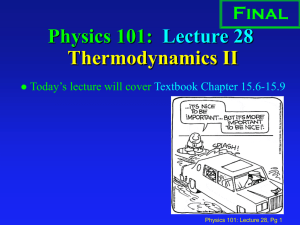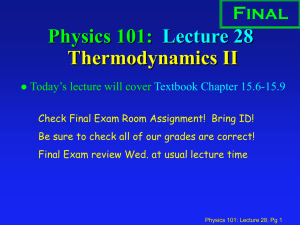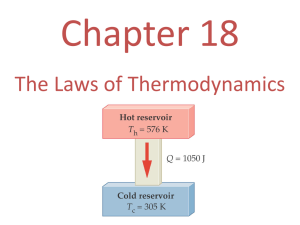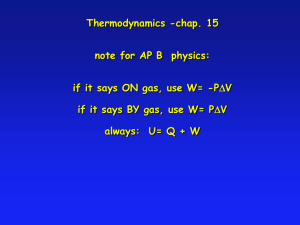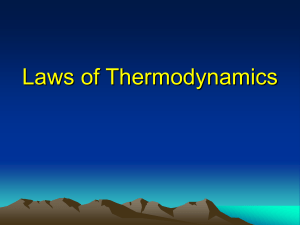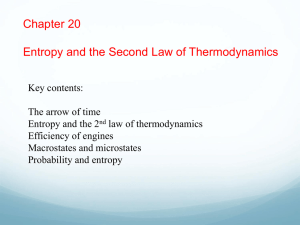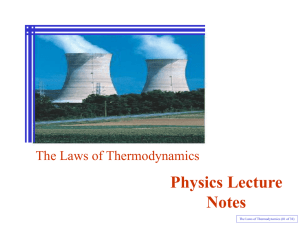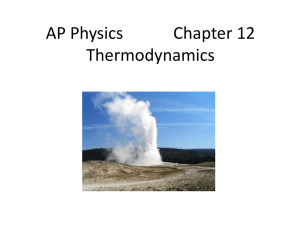Document
advertisement
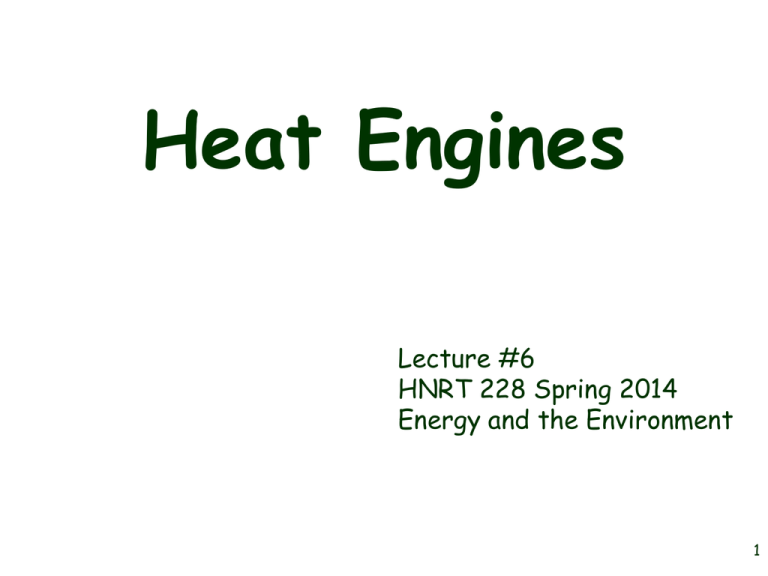
Heat Engines Lecture #6 HNRT 228 Spring 2014 Energy and the Environment 1 iClicker Question • Which shale basin stretches from West Virginia to New York? – A Haynesville – B Woodford – C Barnett – D Marcellus – E None of the above 2 iClicker Question • Which has lowest amount of nitrous oxide emissions? – A Diesel Fuel – B Gasoline Fuel – C Bio-diesel Fuel – D Ethanol-blend Gasoline – E Natural Gas 3 iClicker Question • Which puts the lowest amount of carbon into the environment? – A Oil – B Coal – C Natural Gas 4 iClicker Question • Which natural gas has the highest potential energy content per gram? – A Octane – B Heptane – C Butane – D Methane – E Hexane 5 iClicker Question • Which country has the most coal reserves? – A Russia – B China – C United States – D Australia – E Canada 6 Heat Engines, Heat Pumps, and Refrigerators The Object: Get something useful from heat 7 Heat can be useful • • • Normally heat is the end-product of the flow/transformation of energy – Consider examples coffee mug, automobile, bouncing ball – Typically heat regarded as waste useless end result Sometimes heat is what we want – e.g. hot water, cooking, space heating Heat can also be coerced into performing “useful” (e.g., mechanical) work – this is called a “heat engine” 8 Heat Engine Concept • • • • If a temperature difference exists between two bodies – then there is a potential for heat flow Examples: – heat flows out of a hot pot of soup – heat flows into a cold drink – heat flows from the hot sand into your feet Rate of heat flow depends on – nature of contact – thermal conductivity of materials Some of this flow of energy can be transformed into mechanical work 9 Heat Work • Examples of heat energy transformed into other types of energy – Air over a hot car roof rises gains kinetic energy also gains gravitational potential energy – Wind is driven by temperature differences – Think about radiative heat energy transfer – Electricity generation thrives on temperature differences no steam would circulate if everything was at the same temperature 10 Power Plant Arrangement Heat flows from Th to Tc, turning turbine along the way 11 iClicker Question • Why does heat flow from Th to Tc ? – A 1st Law of Thermodynamics – B 2nd Law of Thermodynamics – C 3rd Law of Thermodynamics – D Newton’s Law – E Prof. Geller said so 12 Heat Engine Nomenclature • The symbols used to describe a heat engine are: – Th is the temperature of the hot object (typ. in Kelvin) – Tc is the temperature of the cold object (typ. in Kelvin) – T = Th–Tc is the temperature difference – Qh is the amount of heat that flows out of the hot body – Qc is the amount of heat flowing into the cold body – W is the amount of “useful” mechanical work – Sh is the change in entropy of the hot body – Sc is the change in entropy of the cold body – Stot is the total change in entropy (entire system) – E is the entire amount of energy involved in the flow 13 What’s this Entropy business? • Recall 2nd Law of Thermodynamics – Entropy is a measure of disorder (and actually quantifiable on an atom-by-atom basis) – Ice has low entropy, liquid water has more, steam has much more 14 What is the generic name for a cyclical device that transforms heat energy into work. A. Refrigerators B. Thermal Motors C. Heat Engines D. Carnot Cycles E. Otto processors 15 What is the generic name for a cyclical device that transforms heat energy into work. A. Refrigerators B. Thermal Motors C. Heat Engines D. Carnot Cycles E. Otto processors 16 Recall Laws of Thermodynamics • • Energy is conserved Total system entropy can never decrease – As the temperature goes to zero, the entropy approaches a constant value—this value is zero for a perfect crystal lattice – The concept of the “total system” is very important: entropy can decrease locally, but it must increase elsewhere by at least as much no energy flows into or out of the “total system”: if it does, there’s more to the system than you thought 17 Quantifying heat energy • • Quantifying heat – 1 Calorie is the heat energy associated with raising 1 kg (1 liter) of water 1 ºC – In general, Q = cpmT, where cp is the heat capacity A change in heat energy accompanies a change in entropy: Q = TS (T expressed in K) • Adding heat increases entropy – more energy goes into random motionsmore randomness (entropy) 18 How much work can be extracted from heat? Hot source of energy Th Qh heat energy delivered from source externally delivered work: W = Qh – Qc heat energy delivered to sink conservation of energy Qc efficiency = Cold sink of energy Tc W Qh = work done heat supplied 19 Rank in order, from largest to smallest, the work Wout performed by these four heat engines. A. B. C. D. E. Wb > Wa > Wc > Wd Wb > Wa > Wb > Wc Wb > Wa > Wb = Wc Wd > Wa = Wb > Wc Wd > Wa > Wb > Wc 20 Rank in order, from largest to smallest, the work Wout performed by these four heat engines. A. Wb > Wa > Wc > Wd B. Wb > Wa > Wb > Wc C. Wb > Wa > Wb = Wc D.Wd > Wa = Wb > Wc E. Wd > Wa > Wb > Wc 21 It’s a really hot day and your air conditioner is broken. Your roommate says, “Let’s open the refrigerator door and cool this place off.” Will this work? A. Yes. B. It might, but it will depend on how hot the room is. C. No. 22 It’s a really hot day and your air conditioner is broken. Your roommate says, “Let’s open the refrigerator door and cool this place off.” Will this work? A. Yes. B. It might, but it will depend on how hot the room is. C. No. 23 Let’s crank up the efficiency Let’s extract a lot of work, and deliver very little heat to the sink Th Qh In fact, let’s demand 100% efficiency by sending no heat to the sink: all converted to useful work W = Qh – Qc Qc efficiency = Tc W Qh = work done heat supplied 24 Not so fast… • • The second law of thermodynamics imposes a constraint on this reckless attitude: total entropy must never decrease The entropy of the source goes down (heat extracted), and the entropy of the sink goes up (heat added): remember that Q = TS – The gain in entropy in the sink must at least balance the loss of entropy in the source Stot = Sh + Sc = –Qh/Th + Qc/Tc ≥ 0 Qc ≥ (Tc/Th)Qh sets a minimum on Qc 25 What does this entropy limit mean? • • W = Qh – Qc, so W can only be as big as the minimum Qc will allow Wmax = Qh – Qc,min = Qh – Qh(Tc/Th) = Qh(1 – Tc/Th) So the maximum efficiency is: max efficiency = Wmax/Qh = (1 – Tc/Th) = (Th – Tc)/Th this and similar formulas must have the temperature in • • Kelvin So perfect efficiency is only possible if Tc is zero (in ºK) – In general, this is not true As Tc Th, the efficiency drops to zero: no work can be extracted 26 Examples of Maximum Efficiency • • A coal fire burning at 825 K delivers heat energy to a reservoir at 300 K – max efficiency is (825 – 300)/825 = 525/825 = 64% – this power station can not possibly achieve a higher efficiency based on these temperatures A car engine running at 400 K delivers heat energy to the ambient 290 K air – max efficiency is (400 – 290)/400 = 110/400 = 27.5% – not too far from reality 27 What, if anything, is wrong with this refrigerator? A. B. C. D. E. It violates the first law of thermodynamics. It violates the second law of thermodynamics. It violates the third law of thermodynamics. It violates both the first and second law of thermodynamics. Nothing is wrong. 28 What, if anything, is wrong with this refrigerator? A. It violates the first law of thermodynamics. B. It violates the second law of thermodynamics. C. It violates the third law of thermodynamics. D. It violates both the first and second law of thermodynamics. E. Nothing is wrong. 29 Could this heat engine be built? A. Yes. B. No. C. It’s impossible to tell without knowing what kind of cycle it uses. 30 Could this heat engine be built? A. Yes. B. No. C. It’s impossible to tell without knowing what kind of cycle it uses. 31 Example efficiencies of power plants Power plants these days (almost all of which are heat-engines) typically get no better than 33% overall efficiency 32 What to do with the waste heat (Qc)? • One option: use it for space-heating locally 33 Overall efficiency greatly enhanced by cogeneration 34 Heat Pumps Heat Pumps provide a means to efficiently move heat around, and work both in the winter and the summer 35 Heat Pump Diagram 36 Heat Pumps and Refrigerators: Thermodynamics Hot entity (indoor air) heat energy delivered Th Just a heat engine run backwards… Qh delivered work: W = Qh – Qc heat energy extracted conservation of energy Qc efficiency = Cold entity (outside air or refrigerator) Tc (heat pump) efficiency = (refrigerator) Qh heat delivered W = work done Qc heat extracted W = work done 37 Heat Pump/Refrigerator Efficiencies • • Work through similar logic as before to see: – heat pump efficiency is: Th/(Th – Tc) = Th/T in ºK – refrigerator efficiency is: Tc/(Th – Tc) = Tc/T in ºK Note that heat pumps and refrigerators are most efficient for small temperature differences – hard on heat pumps in very cold climates – hard on refrigerators in hot settings 38 Example Efficiencies • • A heat pump maintaining 20 ºC when it is –5 ºC outside has a maximum possible efficiency of: 293/25 = 11.72 – note that this means you can get almost 12 times the heat energy than you are supplying in the form of work! – this factor is called the C.O.P. (coefficient of performance) A freezer maintaining –5 ºC in a 20 ºC room has a maximum possible efficiency of: 268/25 = 10.72 – called EER (energy efficiency ratio) 39 Example Labels (U.S. & Canada) 40 Again - First Law of Thermodynamics • • The First Law of Thermodynamics tells us that the internal energy of a system can be increased by – Adding energy to the system – Doing work on the system There are many processes through which these could be accomplished – As long as energy is conserved 41 Again - Second Law of Thermodynamics • • • Constrains the First Law Establishes which processes actually occur Heat engines are an important application 42 Work in Thermodynamic Processes – Assumptions • • • Dealing with a gas Assumed to be in thermodynamic equilibrium – Every part of the gas is at the same temperature – Every part of the gas is at the same pressure Ideal gas law applies 43 Work in a Gas Cylinder • • A force is applied to slowly compress the gas – The compression is slow enough for all the system to remain essentially in thermal equilibrium W = - P ∆V – This is the work done on the gas 44 More about Work on a Gas Cylinder • • • When the gas is compressed – ∆V is negative – The work done on the gas is positive When the gas is allowed to expand – ∆V is positive – The work done on the gas is negative When the volume remains constant – No work is done on the gas 45 Notes about the Work Equation • • If pressure remains constant during the expansion or compression, this is called an isobaric process If the pressure changes, the average pressure may be used to estimate the work done 46 PV Diagrams • • Used when the pressure and volume are known at each step of the process The work done on a gas that takes it from some initial state to some final state is the negative of the area under the curve on the PV diagram – This is true whether or not the pressure stays constant 47 More PV Diagrams • • The curve on the diagram is called the path taken between the initial and final states The work done depends on the particular path – Same initial and final states, but different amounts of work are done 48 iClicker Question • • By visual inspection, order the PV diagrams shown below from the most negative work done on the system to the most positive work done on the system. Hint: Use area formulae for triangles and rectangles. a) a,b,c,d b) a,c,b,d c) d,b,c,a d) d,a,c,b a b c d 49 iClicker Question • • By visual inspection, order the PV diagrams shown below from the most negative work done on the system to the most positive work done on the system. You don’t need formulae for triangles and rectangles. a) a,b,c,d b) a,c,b,d c) d,b,c,a d) d,a,c,b a b c d 50 Carnot Engine • • • A theoretical engine developed by Sadi Carnot A heat engine operating in an ideal, reversible cycle (now called a Carnot Cycle) between two reservoirs is the most efficient engine possible Carnot’s Theorem: No real engine operating between two energy reservoirs can be more efficient than a Carnot engine operating between the same two reservoirs 51 Carnot Cycle 52 Carnot Cycle, A to B • • • • A to B is an isothermal expansion at temperature Th The gas is placed in contact with the high temperature reservoir The gas absorbs heat Qh The gas does work WAB in raising the piston 53 Carnot Cycle, B to C • • • • • B to C is an adiabatic expansion The base of the cylinder is replaced by a thermally nonconducting wall No heat enters or leaves the system The temperature falls from Th to Tc The gas does work WBC 54 Carnot Cycle, C to D • • • • The gas is placed in contact with the cold temperature reservoir at temperature Tc C to D is an isothermal compression The gas expels energy QC Work WCD is done on the gas 55 Carnot Cycle, D to A • • • • D to A is an adiabatic compression The gas is again placed against a thermally nonconducting wall – So no heat is exchanged with the surroundings The temperature of the gas increases from TC to Th The work done on the gas is WCD 56 Carnot Cycle, PV Diagram • • The work done by the engine is shown by the area enclosed by the curve The net work is equal to Qh - Qc 57 Efficiency of a Carnot Engine • Carnot showed that the efficiency of the engine depends on the temperatures of the reservoirs TC ec 1 Th • • Temperatures must be in Kelvins All Carnot engines operating between the same two temperatures will have the same efficiency 58 Notes About Carnot Efficiency • • • • Efficiency is 0 if Th = Tc Efficiency is 100% only if Tc = 0 K – Such reservoirs are not available The efficiency increases as Tc is lowered and as Th is raised In most practical cases, Tc is near room temperature, 300 K – So generally Th is raised to increase efficiency 59 The area enclosed within a pV curve is A. the work done by the system during one complete cycle. B. the work done on the system during one complete cycle. C. the thermal energy change of the system during one complete cycle. D. the heat transferred out of the system during one complete cycle. 60 The area enclosed within a pV curve is A. the work done by the system during one complete cycle. B. the work done on the system during one complete cycle. C. the thermal energy change of the system during one complete cycle. D. the heat transferred out of the system during one complete cycle. 61 The maximum possible efficiency of a heat engine is determined by A. its design. B. the amount of heat that flows. C. the maximum and minimum pressure. D. the compression ratio. E. the maximum and minimum temperature. 62 The maximum possible efficiency of a heat engine is determined by A. its design. B. the amount of heat that flows. C. the maximum and minimum pressure. D. the compression ratio. E. the maximum and minimum temperature. 63 The engine with the largest possible efficiency uses a A. Brayton cycle. B. Joule cycle. C. Carnot cycle. D. Otto cycle. E. Diesel cycle. 64 The engine with the largest possible efficiency uses a A. Brayton cycle. B. Joule cycle. C. Carnot cycle. D. Otto cycle. E. Diesel cycle. 65


